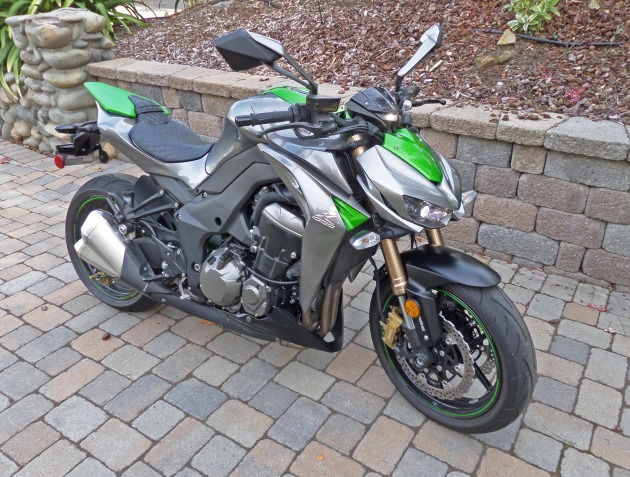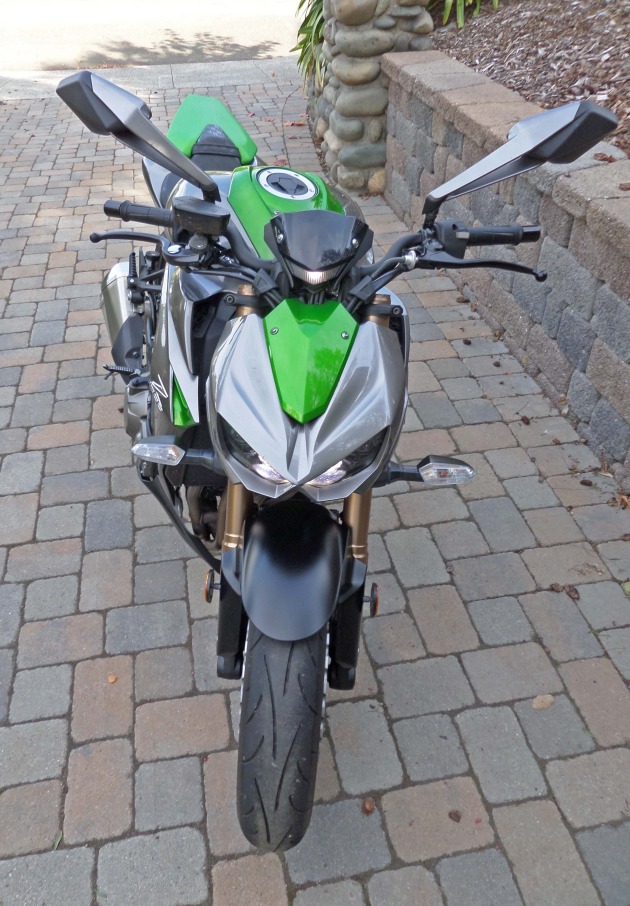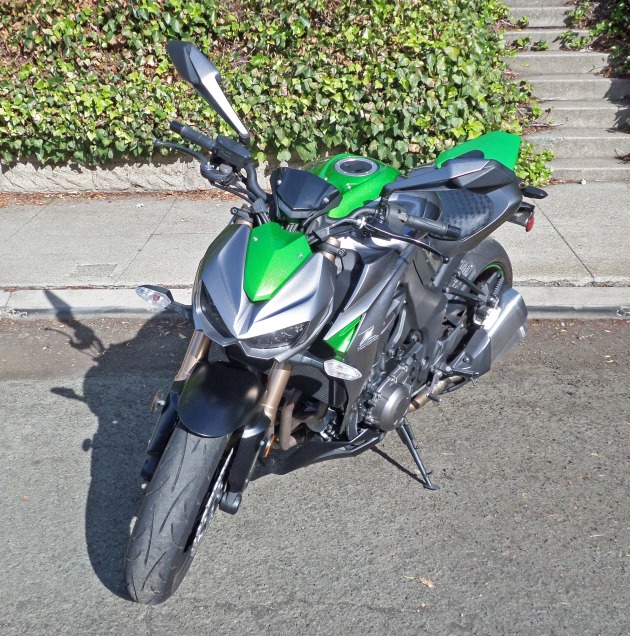?2015 Kawasaki ?Z1000?
An exceptional naked streetfighter

The 2015 Kawasaki Z1000 is an ideal example of, and is the latest in a long line of ?naked? Kawasaki street bikes. This newest Z1000 draws upon more than 35 years of delivering good-looking, great performing sport bikes.
My very first track day took place at Infineon Raceway, now known as Sonoma Raceway (I still think of it as Sears Point Raceway) in Sonoma California. It was during a Keith Code Superbike School that took place on a Monday, following a weekend of Kawasaki sponsored AMA Superbike racing. The school bikes were Kawasaki Ninja 6Rs, which were not at all ideal for my physique ? my elbows were into my knees, and safe, proficient maneuvering was next to impossible. After a couple of attempts at riding the diminutive Ninja, my instructor agreed with me and concluded that the bike was indeed to small for me to ride with any degree of finesse, and opted to allocate a Kawasaki Z1000 as my school steed. Just great I thought ? ?it?s taller, has a 400cc larger displacement, and is thereby more powerful and faster?. There was to be no extreme leaning or knee dragging for this rider.

As it turned out, the Z1000?s riding position was actually considerably more comfortable, and as a result, the bike was much more manageable, and I was able to make it through the day?s exercises without incident and finished unscathed. The Z1000 was a great bike then, but it?s even better today. The XZ1000 is not to be confused with the Kawasaki Ninja1000 ABS, which I reviewed earlier, and is anything but naked ? it even came as a ?bagger?.
Previous Z1000s utilized a steel frame, while the new bike employs an all-new aluminum frame that?s similar in concept to that of the Ninja? ZX?-10R sportbike. The frame beams curve over the engine, resulting in a narrower bike that?s easy to grip with one?s knees, and the engine bolts in solidly at three places, and in a rubber mount at the upper rear of the crankcase as a stressed-member for improved torsional rigidity and solid handling. The main frame and swingarm pivot areas are cast as a single unit, and the rear subframe is a three-piece aluminum, light, smooth die-casting.

There is an attractive, racy new front cowl that slopes back at a sharp angle, highlighting the newly styled nose, which is followed by a tilting instrument panel with an orange lens that may be angled to suit the rider. Just below that a long, narrow headlight represents Kawasaki?s first use of a line-beam unit. Following the lines rearward, the eyes will next encounter an artfully sculpted, 4 gallon steel gas tank, with flared sides to fit one?s knees, and trim at the rear for a snug fit. The seat is low and narrow at the front, with a 32.1-inch height making for easy ground contact, and it flows beautifully rearward, ending in a futuristically retro LED taillight behind a red lens.

Serving as the heart of this new naked Kawasaki streetfighter, is the engine. The engine is a 1043cc four-stroke, liquid-cooled, DOHC, 16-valve inline-four cylinder with Direct FueI Injection through four 38mm Keihin throttle bodies, with oval sub-throttles. It gears power through a six-speed sequential manual transmission, routed to the rear wheel via an X-Ring chain final drive. The exhaust is a carry-over of the quad-pipe theme (a 4-into-2-pre-chamber-into-2 layout), with silencer end-caps maintaining the quad-style image from the last Z1000 (and the first Z1), but with an under-engine pre-chamber that allows the use of shorter mufflers for improved appearance and better mass centralization for light, quick handling. A solid-mount handlebar and aluminum footpegs lifted from the Ninja ZX-10R complete with machined edges contribute to the Z1000?s direct feel.

The Z1000 rides on Dunlop Sportmaxx tires – D210 J 120/70 ZR17 M/C 58W up front, and D210 190/50 ZR17 M/C 75W in the rear, mounted on Mounted on 3-?V?- hollow spoke black painted alloy wheels with a green rim stripe. Suspension componentry consists of 41mm inverted cartridge forks with stepless compression and rebound damping, adjustable spring preload with 4.7-inches of wheel travel up front and a horizontal monoshock with stepless rebound damping, adjustable spring preload and 4.8-inches of wheel travel aft, delivering UNI-TRAK?-like performance.

Bringing the Z1000 to a halt are hydraulic dual 310mm petal-type rotors with radial- mount 4-piston calipers in front, and a single 250mm petal-type rotor with a single-piston caliper out back ? both with ABS.
Dimensionally, the Z1000 is relatively compact, with a 56.5-inch wheelbase, an overall length of 80.5-inches, a height of 41.5-inches and the curb weight is 487.3 pounds.

My test Z1000 was finished in Golden Blaze Green and Metallic Spark Black (actually a Silver Gray), and came with a base price of $11,999. Dealer prep and handling is estimated to bring the final sticker to approximately $12,344. The rider seat is upholstered in a Z-patterned motif, with the passenger pillion (what there is of it) done in a green tone to match that of the bike.
SUMMARY: As already indicated, the 2015 Kawasaki Z1000 represents a vast improvement over its predecessors, and the earlier versions were nothing to turn up one?s nose at. It is more compact, sporting a minimally longer wheelbase, but shorter overall length, and weighs a bit more. The 10433cc four-cylinder motor delivers instantaneous gratification both in terms of performance and sound, with its powerful ?thrum?, when twisting the throttle. The torque range and delivery is broad and smooth. 90+ octane fuel is required. Gear changes are precise and the bike?s balance is exceptional. The ride quality is compliant and seemingly just right ? not too firm and not too soft, and if the ride isn?t to your liking, both the front and rear suspension is adjustable.
The riding position is more upright than that of an ?all-out? sportbike with pegs and controls positioned just aft of the bike?s center. Passenger pegs even have luggage hooks for conveniently securing personal gear. The handlebars feature a width similar to off-road bikes for greater control, and they are rigid mounted. Rear view mirrors are ideally placed for an optimum view rearward. The seats would benefit from more padding on long rides for riders with minimal personal gluteal padding. Other suggestions for achieving the ultimate bike level in its class would be a gear indicator and self-canceling directional signals.

The Z1000 is both fast and fun to ride ? not necessarily for the faint of heart or inexperienced rider, but it can be docile as well if need be. The instrument panel with its multifunction LCD display covers all major operational information. The Tachometer is unique, with a vertical bar graph on the left of the panel up to 4,000 rpm, which jumps to an illuminated, horizontal bar graph at the top.
There are a few less expensive naked sportbikes, and there are more expensive models as well, but the Z1000 is a striking, visually appealing ride that represents an excellent value that also comes with a 12-month warranty. At 6?4?, I was comfortable, but would have appreciated foot controls that were mounted further forward for easier access with my long legs. In the final analysis, the 2015 Kawasaki Z1000 ABS, with its ?Sugomi? styling resembling a crouching predator is a winner that is now more potent and more capable.
[wptabs style=”wpui-light” effect=”slide” mode=”horizontal”]
?[wptabtitle] SPECIFICATIONS: 2015 Kawasaki Z1000 ABS [/wptabtitle]
?? [wptabcontent]
| Base Price: | $11,999. |
| Price as Tested: | $12,344. |
| Engine Type and Size: | 1043cc DOHC, 16-valve, four-stroke, liquid-cooled inline four-cylinder with Direct Fuel Injection and four 38mm Keihin throttle bodies and sub throttles with TCBI digital advance ignition. Exhaust is a 4-into2-prechamber-into-2 setup with dual mufflers on each side. |
| Horsepower (bhp): | 125 @ rear wheel. |
| Torque (ft./ lbs.): | 81.1 @ 7,800 rpm |
| Transmission: | Sequential six-speed manual. |
| Drive Train: | Final drive – Sealed chain. |
| Suspension: |
Front – 41mm inverted SFF-BP forks with stepless compression and rebound damping and spring preload adjustability and 4.7-inches of wheel travel. Rear – Horizontal monoshock with stepless rebound damping, adjustable spring preload and 4.8-inches of wheel travel. |
| Brakes: | Hydraulic Dual 310mm petal-type rotors with radial-mount four-piston monobloc calipers and ABS up front / Single 250mm petal-type rotor with single-piston caliper and ABS in the rear. |
| Tires: | Dunlop SportMax 120/70 ZR17 M/C 58W front / D 214 T 190/50 ZR17 M/C 75W rear. Mounted on Black 3?- hollow spoke alloy wheels with a green rim stripe. |
| Wheelbase: | 56.5 inches |
| Length Overall: | 80.5 inches |
| Curb Weight: | 487.3 lbs. (dry) |
| Fuel Capacity: | 4.5 gallons. |
| Seat Height: | 32.1 inches |
| 0 – 60 mph: | Not tested |
?? [/wptabcontent]
[/wptabs]
 Arv Voss is a Northern California based freelance motoring Journalist and member and past officer of several noted Automotive Journalist organizations who contributes regularly to a number of national and international media outlets. He reviews not only cars, trucks and SUVs, but motorcycles as well.
Arv Voss is a Northern California based freelance motoring Journalist and member and past officer of several noted Automotive Journalist organizations who contributes regularly to a number of national and international media outlets. He reviews not only cars, trucks and SUVs, but motorcycles as well.









